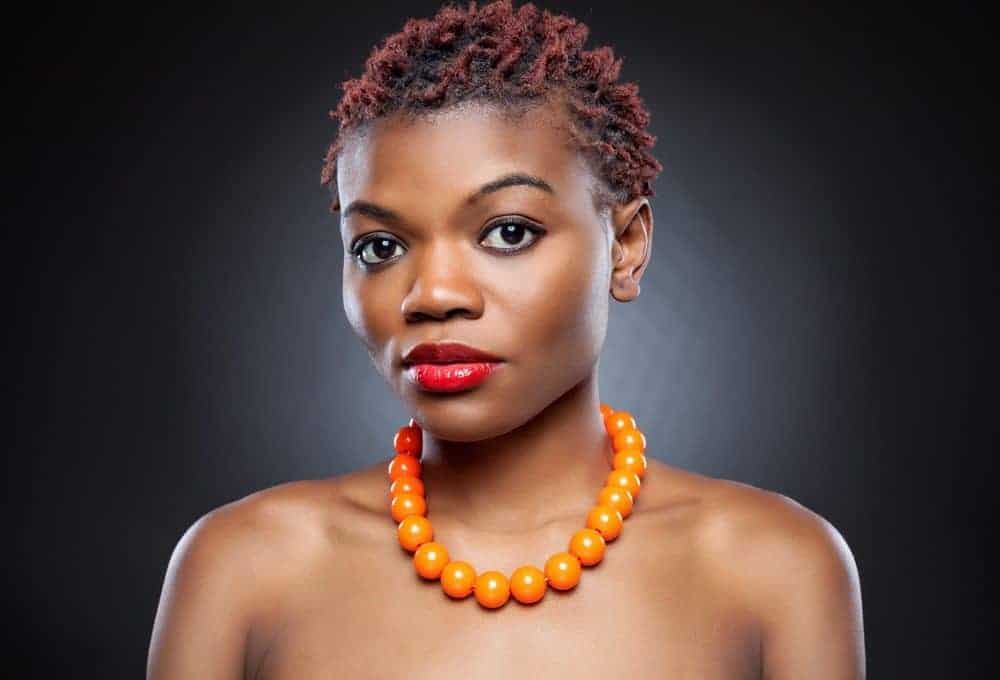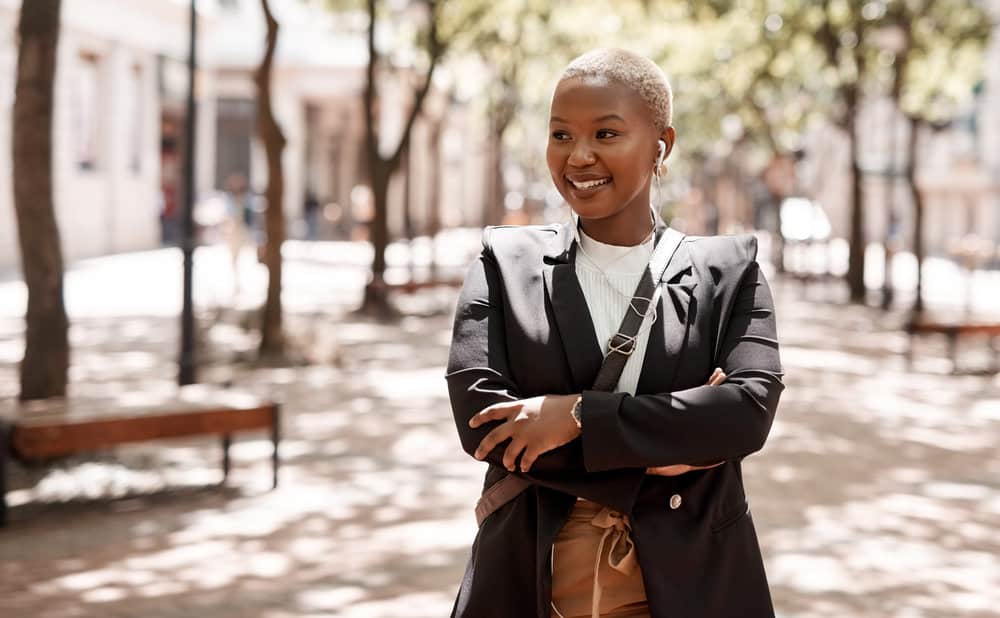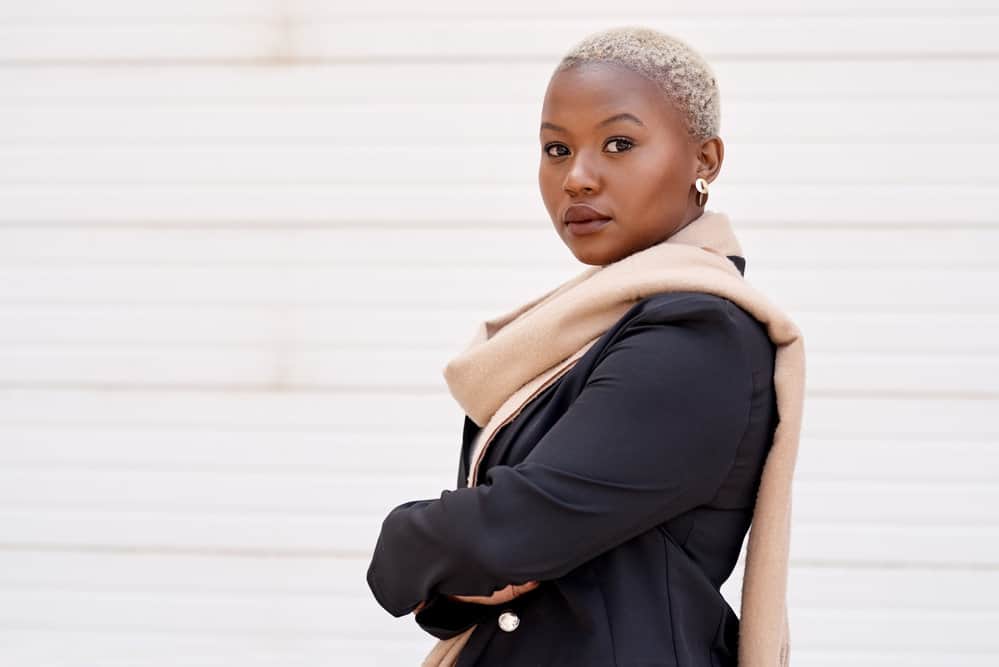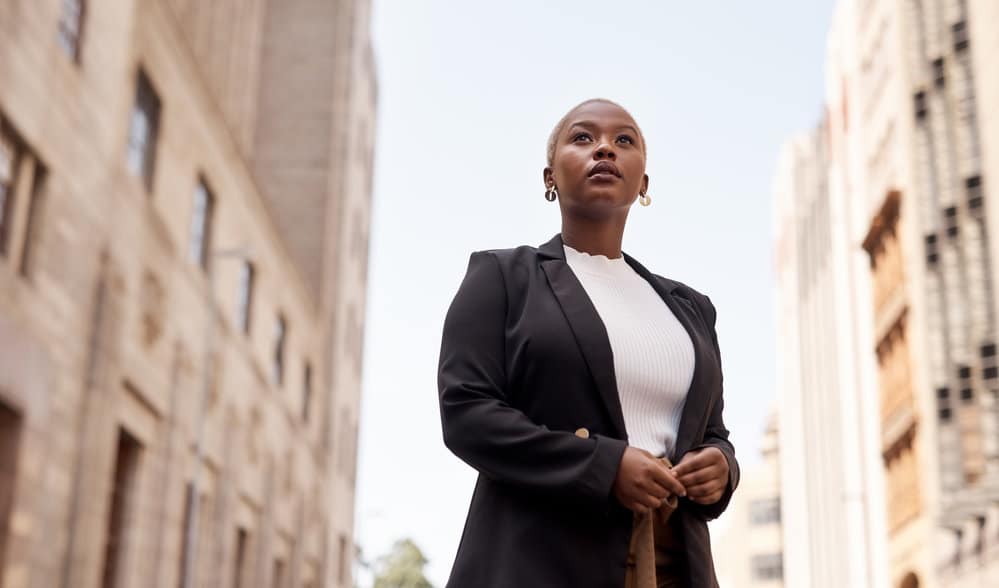
TWA hairstyles are really popular right now as more and more women big chop while going natural. If you’re looking for a simple yet gorgeous way to style your short natural hair, then look no further than a TWA hairstyle.
The TWA hairstyle is effortless to achieve, which makes it great for beginners. Once you’re done, you’ll have defined, soft natural curls ready for any occasion!
Table of Contents
- 1 What Is a TWA?
- 2 How to Do TWA Hairstyles
- 3 Prepare Your Hair for a TWA
- 4 How to Create Your TWA Hairstyle
- 5 TWA and Short Haircut Maintenance
- 6 Pros and Cons of TWA Hair Cuts
- 7 Dos and Don'ts of a TWA Style
- 8 Bantu Knots Tutorial
- 9 Blonde Curly Afro
- 10 Reddish, Brown-Colored Ombre Curls
- 11 Rainbow TWA Color Stripes
- 12 Bright Platinum Blonde Hair
- 13 Edgy Fade
- 14 TWA Curl Sponge Tutorial
- 15 An Afro in Scarlet
- 16 What's the Best TWA Hairstyle?
- 17 The History & Etymology of TWA Hairstyles
- 18 TWA Styles Throughout the Years
- 19 During the 1960s and 1970s: The Impact of the Civil Rights Movement
- 20 TWA Hairstyles Are Very Popular in the 1990s and 2000s
What Is a TWA?
TWA stands for a teeny weeny afro. It's a short natural hairstyle (usually 3 inches or less) often worn by women following big chop during their journey from relaxed hair to natural hair. Although, many women choose to wear a TWA as their primary style.

This article will walk you through the process of creating beautiful TWA hairstyles.
Once you make the decision to go natural, you have a couple of primary options. You can either slowly transition to natural hair, or you can big chop.
More and more women, especially over the past several years, are deciding to big chop, which involves cutting off your chemically relaxed hair in a single session.
We’ve heard time and time again how refreshing and renewing the experience of big chop is for many women. It allows you to start off your natural hair journey with a fresh start.
In fact, it allows you to get rid of chemically relaxed, damaged hair, and it can liberate and empower you, especially if you have become extremely attached to your hair.
However, some women don’t want to cut their hair because hair growth takes time. If you’re confident you can deal with short hair for at least a period of one year, then go for it.
Plus, short hair is gorgeous. For many women, short hair accentuates their facial features and highlights their natural beauty. Just think of wearing your neat natural coils with hoop earrings and a silk scarf.
The hairstyle ideas are nearly endless, and short hair has quite a bit of versatility.
However, if you’ve had long hair for quite some time, you might not know how to style short hair or believe that you’re styling options are severely limited.
We created this collection of short TWA hairstyles to inspire women that need styling ideas.
We have watched seemingly hundreds of YouTube videos, found several cool hairstyles on Pinterest and Instagram, and compiled our favorites within this article.
The styles that we’ve chosen don’t “require” regular cuts or color treatments, although you might find a color-treated hairstyle that you really like on the list.
As your hair starts to grow, some of these styles will look quite a bit different if you don’t cut your hair to maintain the desired look. At any rate, you have several options to create your own unique TWA hairstyle.

How to Do TWA Hairstyles
It is always essential to make sure you have all of the necessary supplies and styling products ready to go before you begin styling. Avoid frustration by gathering your supplies before you start.
Prep Supplies:
- Clarifying shampoo and moisturizing shampoo (unless you’ll be co-washing)
- Moisturizing conditioner
- Moisturizing products of your choice: leave-in conditioner, oil, curl definition cream, etc.
- Wide-tooth comb for detangling
Styling Supplies:
- Spray bottle filled with water
- Rattail comb
- Denman brush
- Styling gel of choice
- Edge control
- Oil, such as coconut oil
- Toothbrush
- Pick

Prepare Your Hair for a TWA
If you’re in pursuit of your best TWA, you’ll want to adequately prep your strands before styling. This means you need to cleanse and moisturize your hair beforehand. Let’s get into the preparatory steps for this style.
Cleanse Your Hair
In case you weren’t aware, there are multiple ways to cleanse natural hair, and each cleansing method has its own merits. We’ll cover two cleansing methods in this section: shampooing and co-washing.
Let’s get into it.
Co-Washing
Co-washing your hair is simply washing your hair with a conditioner rather than traditional shampoo. Co-washing is a great option for naturally curly hair, as it doesn’t strip the moisture from your hair like shampoo can.
Many people co-wash to stretch out the time between shampooing sessions, leading to better-hydrated hair. Due to the benefits of co-washing for moisture retention, there are many products on the market designed specifically for co-washing.
Here are some great co-wash products:
Follow the below steps to properly co-wash:
- Wet your hair thoroughly with warm water to open up your hair’s cuticles.
- Apply the co-wash to your hair in sections, ensuring all of your hair is completely covered and the product is evenly distributed.
- Scrub or massage your scalp to remove dirt and product buildup.
- Rinse with warm water and then proceed to the conditioning steps below.
Shampooing
A shampooing session is needed whenever your hair or scalp is covered in visible debris. If you’ll be washing your hair with shampoo, here are some steps to follow to preserve your hair’s moisture during the shampoo session:
- Wet your hair with warm water. Don’t use hot water, as this can cause dryness.
- Apply a clarifying shampoo, focusing on your scalp. A clarifying shampoo will remove product buildup from your hair, keeping it healthy and promoting growth.
*Allowing product buildup to stay in your hair or on your scalp can clog up your hair follicles, prevent growth, and increase your chances of hair loss.
- Rinse the clarifying shampoo out of your hair, and then repeat with a moisturizing shampoo. Focus again on your roots to remove debris and buildup. This product will restore some of the hydration that was just removed by the clarifying shampoo.
- Rinse your hair thoroughly to remove any traces of shampoo, and then proceed to the conditioning steps below.
Condition Your Hair
After you’ve finished washing your hair with co-wash or shampoo, you should always follow up with a conditioner to hydrate your hair.
Follow these steps to condition your hair:
- Immediately after rinsing out the shampoo, apply the conditioner to all of your hair.
- Work the conditioner in with your fingers or a wide tooth comb to detangle and distribute the product evenly.
- If you have time, put on a shower cap and allow the conditioner to sit in your hair for several minutes. This will allow your hair to absorb as much moisture as possible.
- Rinse your hair with cold water. This will seal in the moisture from the conditioner.
Deep Conditioning (Optional Step)
To achieve an extra defined, shiny and healthy-looking TWA, deep conditioning is a must.
Here are some steps to follow to deep condition your hair:
- Apply deep conditioner to your hair. Comb it through your hair with your fingers or a wide-tooth comb. You should focus primarily on your ends, as this is usually the driest part of your hair.
- Put on a shower cap and allow the product to sit in your hair for 15-20 minutes. You can also use a heat bonnet or wrap a towel over the shower cap to warm up your hair. This will open up the hair follicle, allowing it to soak in as much moisture as possible.
- Rinse your hair well with cold water.
*Deep conditioning can be overdone, so you should only deep condition your hair once every one to two weeks at the most.
Moisturize Your Hair
After conditioning and rinsing your hair, the next step is to add a layer of moisture.
Apply a leave-in conditioner, hydrating oil, or moisturizing cream to your hair and comb it through with your fingers or a wide-tooth comb.
Doing so will distribute the product evenly and allow you to remove any more tangles from your hair before you begin doing your TWA hairstyle.

How to Create Your TWA Hairstyle
Now that you’ve prepared your hair by washing, conditioning, and moisturizing, you are ready to begin styling!
Follow these step-by-step instructions to achieve a gorgeous TWA:
- Start with hair that is wet/damp, detangled, and moisturized. If your hair isn’t wet, dampen it by misting it with your spray bottle of water.
- Divide your hair into three sections. Do this by creating a horizontal part across the top of your head and then parting your hair in the front until you reach the horizontal part.
- You will begin styling at the back of your head. Starting along the nape of your neck, create a part to separate a thin, horizontal row of hair using your rat tail comb.
- Apply hair gel (i.e., holding gel) to the section, and brush through your hair with your Denman brush to distribute the product evenly.
- Shingle your hair for maximum definition. This is done by taking small sections of hair (where your curls naturally separate) and smoothing it out with your fingers.
- Part more horizontal sections and shingle your hair. Repeat the shingling process until you are done with the back section.
- Starting with one of the front sections, use your rattail comb to create rows that are parallel to your front part and perpendicular to the parts that you made at the back of your head.
- Apply gel and shingle the hair in each row, as described above.
- Define and lay down your baby hairs along your hairline using edge control and a toothbrush.
- Allow your hair to air dry, or use the diffusing attachment on your hairdryer to diffuse the curls. If diffusing, you should avoid the hottest temperature setting to prevent heat damage.
- After you’ve styled and dried your hair, you can take an extra step and lift your roots with a pick. This step will make the style look much more natural by separating the curls and removing the defined look of the parts and rows.

Refresh and Style Your TWA
Though the TWA is a protective style that can last up to a week, many ladies struggle to get the style to last more than a day. If you want your curls to look picture-perfect, you may need to refresh the style every so often.
For a light, quick TWA refresh, follow these simple steps:
- Lightly spritz your hair with water.
- Gently fluff your curls to bring back their shape, especially in places where your curls are flat.
- If your curls look dry, apply oil to bring back the shine. Use an oil spray to moisturize your curls without disturbing their shape.
- Allow your hair to air dry.
For a more substantial TWA refresh, follow the below steps:
- Spritz your hair with a spray bottle of water until it is damp but not completely soaked. Doing this will reactivate the products you applied during the initial styling session.
- Apply oil to your curls to replenish moisture.
- Add gel and re-curl any curls that are flat or no longer defined, especially along the hairline.
- Allow your hair to air dry, or diffuse it with a blow dryer on a low setting.
TWA and Short Haircut Maintenance
Maintenance is everything when it comes to a TWA. Sleeping with your hair unprotected can instantly ruin your hairstyle.
To minimize the number of times, you’ll need to refresh your TWA, you should cover your hair up at night with a silk or satin bonnet.
The bonnet will reduce friction between your hair and your pillowcase or covers, keeping your style in place. Also, whenever your hair begins to look or feel dry, you can spray it down with water and oil.

Pros and Cons of TWA Hair Cuts
If you’re not sure whether you want to try a TWA, this section will be helpful. We have compiled a list of TWA pros and cons to assist you in determining whether the style is right for you.
Pros
- Using moisturizing and nourishing products when styling your TWA is a great way to promote healthy hair growth, especially if you’ve done a big chop to get rid of damaged hair.
- Defining your TWA curls will not take a long time once you get the hang of the shingling technique.
- This TWA style is an excellent opportunity to part your hair in a different location and to give your scalp a break from tension caused by some protective hairstyles.
Cons
- This style will not last as long as most protective styles, and your hair will need to be restyled after a few days once the curls lose their definition.
- The TWA style requires you to use quite a bit of gel, which could get expensive.
Most naturals who try the TWA find that the pros outweigh the cons, but you will have to be the judge. If the style takes too much work to maintain, you can always wear a wash-and-go hairstyle.

Dos and Don'ts of a TWA Style
For anyone who decides to try the style, it’s essential to know the Dos and Don’ts. TWAs can go wrong if done incorrectly. Read the below Dos and Don’ts to get the best results.
Do:
- Always start this style with detangled hair, as this will make the process much quicker and easier.
- Use a defining gel that will hold the curls when styling.
- Try multiple gels if necessary. Some gels leave noticeable buildup on the hair and the only way to know if a particular gel leaves buildup is to try it.
- Be patient with yourself. If you’re a beginner and struggle with the shingling technique at first, don’t give up. Going through some trial and error is worth it to achieve this beautiful style!
Don’t:
- Don’t skip out on making sure your hair is clean and moisturized before styling. This is always a good idea as it will prevent product buildup and promote healthy hair growth.
- Don’t rush, as it increases your risk of snagging or breaking your strands.
Bantu Knots Tutorial
If you’re familiar with bantu knots, you may be aware of the historical significance of the hairstyle and the Bantu people. Regardless, bantu knots are an amazing hairstyle for short natural hair.
Now it’s important to note that your knots or “mini buns” will be small if your hair is short. However, some women add extensions to their hair to create larger bantu knots. In this video, Janise provides a short natural hair routine for 4C hair types.
Blonde Curly Afro
You don’t always have to stick with the textbook definition of a TWA. You can grow out your curls a bit longer and add a little blonde hair color for a sweet buttery hue.
Then you’ll have a pretty hairstyle that can frame your face perfectly. Just ask Lorissa, who provides a quick tutorial on how she styles her blonde curly afro.
A blonde, bronze, or honey hue is something that can give life and dimension to any TWA. It still looks natural but has a warmer feel to it than any other color.
Reddish, Brown-Colored Ombre Curls
Have you seen all those cute ombre hairstyles on Pinterest or Instagram? If so, you’ll notice that they are usually posted by women with long hair.
Did you know that you could also rock a beautiful curly reddish, brown-colored ombre TWA hairdo? It’s a fun hairstyle that’s simply stunning.
Pastel colors work extremely well with afros. If you ever get tired of the usual pinks and blondes, you can try a rainbow-colored one!
In this video, Lorissa provides a step-by-step tutorial on how she applies Shea Moisture Color Creme (Medium Chestnut).
A chestnut brown hue works well with TWA hairstyles because of the fact that if you grow it out, you’ll get a natural ombre look. It’s one of the best-looking TWA hairstyles in my opinion.
Rainbow TWA Color Stripes
Another great way to make your TWA stand out from the rest of the crowd is to decorate it with colored stripes. Choose colors that work well together or those that have a nice contrast.
As Makeup By Carrie shows in this video, you can dare to be different even when it comes to your hair. If you’re raring to try something new, edgy, and innovative with your hairstyle, then get this could be the perfect hairstyle for you.
Bright Platinum Blonde Hair
What better color to illuminate your face than a bright blonde hue? This ultra-short TWA style is perfect for those who feel very adventurous with their look and the color is just right.
This style also works really well for those ladies that have high cheekbones to show off, as many of the women in my family.
This style also reminds me of the beautiful buzzed hairstyle made popular by Amber Rose, although Tyiesha Zhane’s hair is longer than Amber’s hairstyle in this video.
In this video, Tyiesha provides a DIY tutorial on how to bleach natural hair to a platinum blonde color. You can channel Tyiesha’s style by wearing a shaved afro hairdo and following her hair coloring tutorial.
If you’re worried about looking nearly bald, you can always keep the top of your hair a bit longer and have only the sides shaved low if you like.
Edgy Fade
Get that razor out and try shaving the sides of your head, leaving just a little bit of hair on top for some character. If edgy is your middle name and wear an edgy fade, this style might be perfect for you.
This hairdo involves shaving (really tapering) the sides of your head for a look that is as epic as it is unique. Edgier still, extra points if you opt to give your TWA a little bit of color on top for a unique look.
Yes, the flat top is a hairdo as old as time, but you can try spicing things up by getting a shaved angle on the side. This, in turn, can add definition to a side part.
The top should be a bit longer and styled in a squarish shape for that no-nonsense yet stylishly cool look. The key is to have fun and be willing to create unique TWA hairstyles.
TWA Curl Sponge Tutorial
In this video, Nia Hope provides a detailed, well-explained tutorial on defining your TWA curls using a curl sponge. If you’re the type of girl who wants to keep her hair natural, don’t fret, you can still have a lot of fun with your afro.
You could always try having an interesting shaved design on your head or getting a colorful asymmetrical cut.
Although, there's nothing wrong with keeping it plain (i.e., natural). Just embrace your ultra-tight, uncolored ringlets and let them hug your face, and show off your best features.
Having a buzzed afro or cute trimmed curls is as simple as you can get. The best thing of all, this style requires minimal styling. Just remember to get regular haircuts to keep the length short if that’s the look that you’re trying to achieve.
An Afro in Scarlet
In this video, YonkelC demonstrates how to maintain red color-treated natural hair. Forget the boring old blues, pinks, and blondes that most people go for nowadays.
Just kidding, but if your TWA needs a unique color that can freshen it up, what better color would it be than a deep red? This color says sassy and chic in just one go.
What's the Best TWA Hairstyle?
So, we’ve provided a few examples of beautiful TWA hairstyles for women with natural hair. Some styles are a little more edgy, like the rainbow hair color afro or the TWA style with tapered sides.
One of my favorites is the “caramel goodness” (i.e., blonde hairstyle). Just keep the hair on the top of your head a little longer than the sides, and add a little bit of hair coloring to make the curls caramel-colored.
I love it when the ladies style their curls on top a bit funkier for that extra cuteness. We already covered warm colors such as blonde, pink, red, and orange, but how about if we go the opposite route?
You could also rock a cool, stark white-blonde style that would be as striking as hair dyed in any other color. We've also seen ladies incorporate side parting,
The styling options are plentiful, there is just so much variety and creativity. Plus, I'm a huge fan of how short natural hair highlights facial features and accentuates natural beauty.
Let us know which styles are your favorites in the comments section.

The History & Etymology of TWA Hairstyles
The teeny weeny afro (TWA) is also commonly referred to as a “fro” or “natural”. TWA hairstyles are usually worn by people with naturally kinky, curly hair types.
This style is also frequently worn by women who have recently transitioned from relaxed to natural hair by big chopping.
People without naturally curly hair (i.e., straight hair) can adopt this hairstyle with the help of hair products, such as gels or creams, to create an afro look.
This hairstyle was very popular in the early 60s within the African American community.
During this time, African Americans would use an “Afro Pick” or a wide-toothed comb to maintain their Afro's shape during the day. The term “Afro” actually comes from the expression “Afro-American.”
This hairstyle, especially the shorter version, was called a “natural” because the hair is worn in its natural form.
The style could be created without the use of any hair products, chemicals, straightening agents, or relaxers. Note that this same style is now commonly referred to as a TWA style.
TWA Styles Throughout the Years
Before the 1960s, some African Americans wore afros in tight kinks. These hairstyles were described as nappy, cottony, or coarse.
These traits were almost the exact opposite of what was supposed to be the standard of beauty in European American norms. Therefore, afros were often seen as unappealing.
As time went on, straight hairstyles became more popular among African Americans. The key to straightening the hair is through the use of relaxers like lye and other caustic substances.
An experienced hairstylist is needed to relax the hair and avoid burning sensitive parts of the head, such as the ears and the scalp.
Hot combs were also used in the 1960s to straighten natural hair temporarily. Today the hair can be straightened temporarily using a flat iron.
There were also other ways to style the hair if the individual didn’t like their hair straightened. For example, braiding hairstyles, like the popular goddess braids and box braids, were worn by many women.
Many of these hairstyle preferences could cause damage to the hair shaft if done incorrectly. This could lead to problems such as hair loss later on in life.

During the 1960s and 1970s: The Impact of the Civil Rights Movement
One of the effects the Civil Rights Movement had was a profound renewal in the African American sense of identity.
The community redefined its sense of style and moved away from the norms of white society, going back to its roots in black aesthetics.
This movement was known as "Black is Beautiful" and restarted the practice of many women wearing natural hair. The afro was used as an icon of black pride.
Some critics dismissed the notion of the afro being used as an icon of black pride.
Kobena Mercer, in his book titled 'Welcome to the Jungle: New Positions in Black Cultural Studies', mentioned that the contemporary, mid-20th-century African society didn't see the afro as an African staple.
Brackette Williams, in her book titled 'Stains on My Name, War in My Veins: Guyana and the Politics of Cultural Struggle' also stated that the adoption and popularization of the afro was a nuisance to some African nationalists because some see it as Western arrogance.
The afro was an inexpensive style. It also provided an alternative to the usual straightened, relaxed, or braided styles that many people wore.
The hairstyle expanded not only within the African American community but it spread outside the community as well.
Some of the most notable sociopolitical figures and entertainers who wore giant afros include Jimi Hendrix (rock star), Pam Grier (actress), Angela Davis (activist, scholar, and writer), and The Supremes and the Jackson 5 (R&B groups).
TWA Hairstyles Are Very Popular in the 1990s and 2000s
The afro "came back" as a favorite hairstyle in the 90s and continues to be popular today.
It also has evolved into many different forms, with some afro hairstyles making use of twists, beads, and braids in various sizes. As this article shows, TWA hairstyles are very popular right now.
Some of the more notable celebrities who wore afros include NBA basketball star Kobe Bryant (in his early days). Renowned musicians include rock star Lenny Kravitz and singer and songwriter Erykah Badu.
- Why Did My Hair Get Shorter When I Didn’t Cut It
- How to Weave Short Hair Without Glue
- Best Hair Extensions for Very Short Hair
- Does Short Hair Make Your Face Look Fatter?
There you have it - a simple way to achieve the elegant and trendy TWA hairstyle for your short, naturally curly hair. If you complete this style and refresh it after a few days using the steps listed above, you can make it last a week or more.
It’s crucial to remember to be patient with yourself as you are learning new ways to style your hair. You may have a few failed TWAs, and when this happens, try again. Soon you’ll get used to the styling process and become a pro at creating teeny-weeny afro styles!





